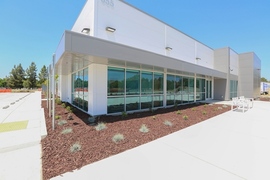 |
Date Announced: 22 May 2018
Additive manufacturing hub at LLNL features laser powder bed fusion and diode-based metal additive manufacturing systems.
Representatives from more than 30 companies in the additive manufacturing (3D printing), automotive and aerospace industries got their first glimpse last week at Lawrence Livermore National Laboratory’s (LLNL) newest facility, the Advanced Manufacturing Laboratory, located in the Livermore Valley Open Campus (LVOC).
The sneak preview was part of a “Partnering for Success” event designed to spur interest in industry and academic collaboration. Following presentations on Lab efforts in advanced manufacturing, company CEOs, managers and engineers toured the $10 million, 14,000 square-foot facility, scheduled to open later this summer.
“When we designed the facility, we wanted it to be flexible,” said LLNL materials scientist Eric Duoss, one of the event’s speakers and tour hosts. “We tried to look ahead and prepare for the future.”
The first-of-its-kind facility features a large wet lab with a dozen fume hoods, where 3D printing, materials research, chemical work, carbon capture technology and other research activities can be performed. A 5,000 square foot dry lab will house industrial-size manufacturing machines, including laser powder bed fusion and diode-based metal additive manufacturing systems, with space for metrology and characterization as well. The Laboratory is bisected by a viewing corridor allowing visitors to observe ongoing activities and has a conference room and shared work areas geared toward collaborative engagements.
“This will be a good opportunity to push the state of the art,” said Tom Markel, a strategic accounts manager for Aerotech, a U.S. maker of motion control products. “When you can work with a national lab you can get the companies together with the best minds here to make things go faster. Seeing what the industry is doing and what Livermore is doing, helps us see where we want to go. I think you’ll get a lot of people in here to do projects because they’ll have access to the scientists.”
Steven Adler, CEO of A3DM Technologies, an additive manufacturing company based in Burlington, Vermont, called the AML “very impressive,” and said he was already envisioning collaborations in metal powders and processes.
“I wanted to reach out (to the Department of Energy labs) and circumstantially, this popped up -- it was exactly what we were looking for,” Adler said. “This new building is remarkable, it’s well thought-out and well-engineered. In private industry, there are things we can’t afford, so hopefully we’ll find projects that dovetail with what the Lab is doing and have opportunities to maybe license that technology developed here. I walk away encouraged by the consensus I saw of a desire to work together.”
Prior to the tour, the dozens of attendees arrived at the HPC Innovation Center in the LVOC to hear presentations on the Lab’s advances in additive manufacturing, design optimization, part qualification and certification, and had discussions of how recent and ongoing Lab research and development into novel machines, manufacturing processes and materials could be applied to problems facing industry.
LLNL’s Director of the Additive Manufacturing Initiative Chris Spadaccini gave an overview of LLNL’s advanced manufacturing program. He said the AML is a result of the Lab’s desire to improve responsiveness and learn from external partners by actively pursuing collaborations with industry and academia that could benefit both parties.
“We’re looking for equal investors and complementary ‘spin in/spin out’ projects where we can help companies and vice versa,” Spadaccini said. “It’s not a pay-to-play facility. We hope and expect that this will accelerate development of advanced manufacturing technology that will benefit both our external partners and our internal programs. We expect students and postdocs to be here and see this as a recruiting pipeline as well. We hope our partners will help guide AML’s future, and we want to learn as much from them as they do from us.”
Calling additive manufacturing “the future,” WCI Principal Associate Director Charlie Verdon explained how the research supporting the Lab’s national security mission could benefit industry, while at the same time, the potential strategic partnerships enabled through the AML could allow the Lab to take a cue from industry to speed up the process of getting technology to market.
“It’s my hope that a partnership would be a two-way street, that our individual competencies would be brought together to create something larger than the individual parts,” Verdon said. “We are seeing the promise, but there’s a lot more work to be done. Industry has to go fast to stay viable and if we can re-learn how to do that, that also will be a benefit to us as a Laboratory.”
The AML, located on the east side of the Lab complex, is nearing completion and workers will begin moving in equipment this summer. It is the first building constructed as part of the redesigned and expanded LVOC and will eventually sit outside the fence to enable easier access for external partners.
“The AML is enabling a new business model for LLNL to team with industrial and academic partners and the success of these collaborations could provide a template for public-private partnerships in the future,” said Anantha Krishnan, associate director for Engineering at the Laboratory.
Last week's event concluded with afternoon breakout sessions in applications, materials, processes, design optimization, and qualification and certification, as well as one-on-one sidebar discussions on potential projects.
Industrial and academic partnerships are expected to begin in the summer. Companies or universities interested in partnering with the Lab can visit the FedBizOpps site for more information and to formally express interest in collaborative work.
Source: LLNL
E-mail: via web site
Web Site: www.llnl.gov
| © 2025 SPIE Europe |
|